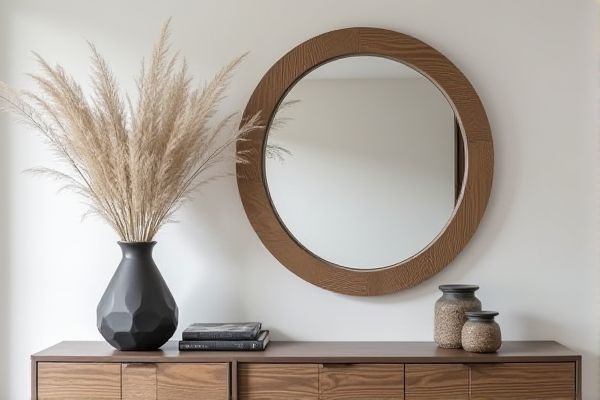
Geometric mirrors, characterized by sharp angles and clean lines, create a modern and structured aesthetic, while oval mirrors offer a softer, more organic shape that adds elegance and warmth to any space. Explore the rest of the article to discover which mirror shape best complements your interior style and personal taste.
Table of Comparison
| Feature | Geometric Mirror | Oval Mirror |
|---|---|---|
| Shape | Defined polygons (square, rectangle, hexagon, etc.) | Elliptical, rounded edges |
| Aesthetic Style | Modern, structured, contemporary | Elegant, soft, traditional |
| Design Flexibility | Varied geometric shapes, angular lines | Consistent smooth curves |
| Common Uses | Bathrooms, offices, decorative walls | Bedrooms, living rooms, classic interiors |
| Visual Impact | Bold, eye-catching, structured | Subtle, graceful, softens space |
| Frame Options | Metal, wood, minimalistic frames | Ornate, wooden, vintage styles |
| Space Suitability | Modern and minimalist interiors | Traditional and cozy interiors |
Introduction to Geometric and Oval Mirrors
Geometric mirrors feature precise shapes such as squares, rectangles, triangles, or hexagons, offering a modern and structured aesthetic that complements contemporary interiors. Oval mirrors provide a softer, more organic shape that adds elegance and fluidity to any space, enhancing visual appeal without overwhelming design elements. Both mirror types serve functional purposes while contributing distinct stylistic influences to home decor.
Defining Geometric Mirrors
Geometric mirrors are characterized by precise shapes such as squares, rectangles, triangles, and polygons, offering clean lines and symmetrical forms that enhance modern and minimalist interior designs. Unlike oval mirrors, which feature smooth, curved edges that create softer, more organic aesthetics, geometric mirrors emphasize sharp angles and structured patterns. The defining feature of geometric mirrors lies in their ability to provide visual balance and architectural interest through their distinct, mathematically inspired shapes.
Characteristics of Oval Mirrors
Oval mirrors feature a smooth, elongated shape with continuous curves that enhance visual appeal and create a sense of softness in interior design. They offer versatile framing options and provide a more expansive reflection area compared to traditional geometric mirrors, making them ideal for adding elegance and depth to various spaces. Their unique shape complements both modern and classic decor by balancing aesthetics and functionality effectively.
Aesthetic Appeal: Geometric vs Oval Designs
Geometric mirrors offer a bold, modern aesthetic characterized by sharp angles and symmetrical patterns that enhance contemporary interiors. Oval mirrors provide a softer, timeless look with smooth curves that complement classic and elegant decor styles. Your choice depends on whether you want to highlight structured, dynamic lines or introduce gentle, flowing shapes to your space.
Versatility in Interior Design
Geometric mirrors offer bold shapes like hexagons and triangles that create modern, artistic focal points, enhancing contemporary and eclectic interiors with structured symmetry. Oval mirrors provide softer, flowing contours that complement traditional, vintage, and minimalist styles by adding elegance and visual balance. Both mirror types enhance spatial perception and light reflection, but geometric mirrors tend to suit dynamic, statement-making designs, while oval mirrors excel in timeless, graceful aesthetics.
Space Perception and Light Reflection
Geometric mirrors, with their sharp angles and symmetrical shapes, enhance space perception by creating structured reflections that can visually expand or define a room's dimensions. Oval mirrors offer softer, curved edges that diffuse light more evenly, promoting a warm and inviting ambiance while subtly amplifying natural and artificial light. Both types influence spatial perception and light reflection differently, with geometric mirrors emphasizing clarity and boundaries, and oval mirrors enhancing fluidity and light distribution.
Comparing Frame Materials and Finishes
Geometric mirrors often feature frames made from metal or wood with sleek, modern finishes like matte black, brass, or gold, highlighting sharp angles and clean lines. Oval mirrors typically have frames crafted from materials such as wood, resin, or metal, with finishes ranging from antique bronze and distressed wood to glossy lacquer, enhancing their soft, elegant curves. Your choice depends on the desired aesthetic, where geometric mirrors create a contemporary vibe and oval mirrors offer a classic or vintage appeal.
Placement Recommendations for Both Styles
Geometric mirrors, characterized by sharp angles and unique shapes like hexagons or triangles, are best placed in modern, minimalist spaces to create focal points above mantels, console tables, or in entryways where their distinct outlines enhance architectural features. Oval mirrors, with their smooth, curved edges, complement traditional, vintage, or eclectic interiors and are ideal for bedrooms, bathrooms, or living rooms, especially when positioned above vanities or sofas to soften the ambiance and reflect light evenly. Both mirror styles benefit from placement at eye level and balanced surrounding decor to maximize their aesthetic impact and functionality.
Maintenance and Durability Considerations
Geometric mirrors with sharp edges often require frequent cleaning to maintain their defined lines and can be more prone to chipping or damage due to their corners. Oval mirrors typically have smoother edges that are easier to dust and less likely to suffer from impact wear, enhancing their durability over time. When choosing your mirror, consider the maintenance intensity and lifespan you prefer to ensure long-lasting aesthetics.
Choosing the Right Mirror for Your Space
Geometric mirrors offer a modern, structured look with sharp lines and angles that can enhance minimalist or contemporary interiors, while oval mirrors provide a softer, classic aesthetic perfect for adding elegance and warmth. Consider the shape and size of your space: geometric mirrors work well in larger, open areas to create visual interest, whereas oval mirrors suit smaller spaces by reflecting light and making the room feel cozier. Your choice depends on whether you want to emphasize bold architectural features or create a gentle, inviting atmosphere.
 homyna.com
homyna.com